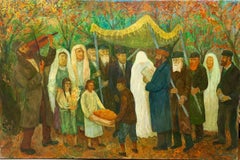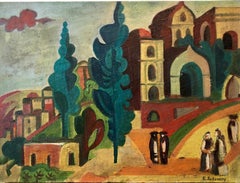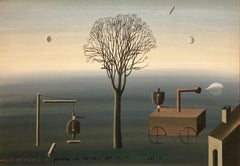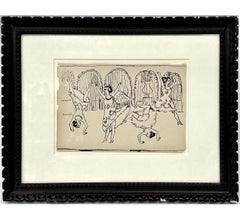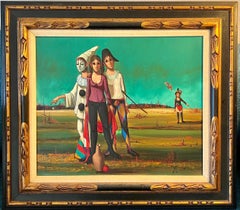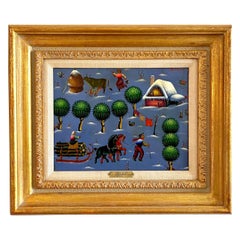WEISBUCH, Claude. Oil on Canvas "Clown a la Colerette" 1961. Signed lower right, further signed, titled and dated verso. Dimensions: 18.25" high x 24" wide.
Claude Weisbuch, 1927-2014 French painter, draftsman and engraver. He studied at the Ecole des Beaux-Arts (School of Fine Arts) in Nancy and upon graduation became a professor of engraving at the Ecole des Beaux-Arts de of St. Etienne. His first solo exhibition was in 1957.
In 1968 , he became a full member of the Society of French Painters-Engravers .
In 1997 he was awarded the Legion of Honor
His work is essentially devoted to engraving, by which he likes to translate, thanks to the line, the life, movement and character of his characters: Punchinels, harlequins, musicians or equestrian scenes. He practices various techniques ( lithography, drypoint etching etc.) that he puts to use in the illustration of bibliophile books.
Claude Weisbuch is also a painter and draftsman. His favorite colors are ochres, browns and whites, with which he seeks to introduce the effects of light by compositions where the line and finesse of the drawing preserve the life found in his engravings.
His precise and dynamic line delivers a moving and swirling work on themes he loves: theater, opera, equestrian, musicians, card players, Kabuki dancers and many portraits.
His works have the appearance of unfinished sketches mixing few colors but a great vivacity of the line. He illustrated many limited edition signed fine art books. Alon with Christo, Arman and Cesar he is considered among the great post war French artists of the last generation.
Exhibitions
1957: Saint Placide Gallery, paintings and engravings
1958: Galerie de Presbourg, Paris, paintings - Saint Placide Gallery, Paris, paintings - Galerie des Arts, Nancy, etchings
1960: Galerie Hervé, "Extraordinary Pantomimes", Paris, paintings
1961: Salon of the young painting and painters witnesses of their time
1962: O'Hanna Gallery, London , paintings
1963: Galerie Hervé, "Portrait Of Man", Paris, Paintings - Nichido Gallery, Tokyo, Paintings
1965: Hervé Gallery, "100 Drawings", Paris Dresdener Gallery, Toronto, paintings
1966: Dantesca Gallery, Turin , paintings, engravings, drawings
1968: New Vision Gallery, Paris, engravings
1969: Galerie Hervé, Paris, paintings - Galerie Reflets, Brussels , prints, paintings - Galerie Dresder, Montreal , paintings
1970: Taménaga Gallery, Tokyo, paintings - Sagot Gallery - The Garrec, Paris, etchings - Museum of Modern Art of the City of Paris ARC, Paris, prints 5
1971: War Gallery, Avignon , etchings Biennial of Engraving, Epinal
1972: Dantesca Gallery, Turin Festival, Sarlat , paintings
1973: Wayss Gallery, Nancy , paintings, engravings, drawings Auguste Comte Gallery, Lyon , paintings, engravings, drawings Taménaga Gallery, Tokyo, paintings - New Vision Gallery, "Homage to Rembrandt", Paris, etchings
1974: Esthetika Gallery, Kortrijk, engravings - Galerie Hervé Odermatt, Paris, paintings Ésthetika Gallery, Kurne, prints - Galerie Wayss, Nancy, engravings, drawings, pastels Dietesheim Gallery, Neuchâtel , engravings - Grafikhuset Gallery, Stockholm , prints, drawings
1975: Schwarzer Gallery, Vienna , engravings, paintings, drawings Fogola Gallery, Turin, drawings, pastels Sotheby-Parke Benett, Munich, engravings, drawings Hervé Odermatt Gallery, Paris, drawings Joly Gallery, Washington , engraving
1976: Taménaga Gallery, Tokyo, paintings - Wayss Gallery, Nancy, engravings, drawings - Tabula Gallery, Tübingen, engravings, drawings - New Vision Gallery, "The horse-The painter and his model", Paris, drawings, engravings
1977: Grafikhuset, Futura, Stockholm - Jivô Gallery, Vänersborg Pigalle Gallery, Norrköping Celsius Gallery, Uppsala Möbius Gallery, Gothenburg - New Vision Gallery, Jerusalem - Cultural Center of Sainte-Menehould Castle, retrospective, engravings
1978: David Barnett Gallery, Milwaukee , engravings, drawings Orangery Gallery, Cologne , engravings, drawings, pastels Grafikhuset Futura, Stockholm, paintings, drawings Les Cordeliers, Châteauroux, engravings, drawings, paintings House of Culture, Montbéliard, engravings House of Culture, Chelles , engravings, paintings, drawings
1979: L'Empreinte Gallery, Strasbourg, prints, drawings - Galerie Reflets, Brussels, prints, drawings - Galerie Bon à tirer, Los Angeles , prints, pastels
1980: Hervé Odermatt Gallery, Paris, "Calligraphy of the figure", paintings - E. Gollon Gallery, Saint-Paul-de-Vence
1981: European Biennale of Engraving, Baden-Bade Galerie The Art Shop, Nice Galerie Hélène Trintignant, Montpellier Martine Remy Gallery, Strasbourg
1982: Vallen Gallery, Stockholm - Sagot Gallery - The Garrec, Paris - Taménaga Gallery, Tokyo, paintings - New Vision Gallery, Tokyo, Nagoya, Osaka, etchings
1983: Hélène Trintignant Gallery, Montpellier
1984: Perrine Museum, Laval , etchings - Music Festival, Quimper , etchings Etchings, Moscow - Presence Gallery, Brussels, paintings, etchings
1985: Galerie Moyon-Avenard, Nantes, paintings - Taménaga Gallery, Paris, paintings - New Otani Hotel, Ōsaka, realization of murals
1986: Taménaga Gallery, Tokyo, paintings - Greenhouse of the School of Fine Arts, Saint-Étienne , paintings, engravings
1988: Retrospective paintings, Château de Chenonceau Retrospective engravings, Artothèque Museum Montpellier Taménaga Gallery, Paris, drawings, pastels New Vision Gallery, Tokyo, engravings
1989: Galerie Taménaga, Paris, paintings
Exit of the book Weisbuch , texts of Jean-Denis Bredin of the French Academy, preface by Jean-Marie Tasset.
1990: Taménaga Gallery, Paris, paintings
1992: Retrospective, Sarlat - Taménaga Gallery, Paris, drawings
1993: Taménaga Gallery, Tokyo and Osaka
1994: Paintings for the second international meetings of the cello ensemble, Beauvais - Elegance Gallery, Taipei - Sanbi Gallery, Tokyo, graphic works - Mitsukoshi, Tōkyō
1995: Taménaga Gallery, Ōsaka - Exhibition of the Gobelins Municipal Circle, Paris 13 th
1996: 2nd Music Trades Fair, Premonstratensian Abbey , Pont-à-Mousson , paintings - Ginza Spring, Tokyo, paintings - New Otani Museum, Tokyo, paintings
1997: Galerie Raugraff, Nancy, paintings, pastels, drawings, engravings, lithographs - Theater Gallery, Besançon, paintings, drawings, engravings, lithographs
1999: A retrospective "Weisbuch, 50 years of prints", 230 works exhibited in Strasbourg under the direction of its publisher, L'Estampe Éditions 3 - Taménaga Gallery, Paris, Tōkyō
2000: Retrospective Château de Vascœuil , by L'Estampe - Theater Gallery, Besançon , paintings, drawings, engravings, pastels, lithographs - Retrospective Chamber of Commerce, Strasbourg - engravings (retrospective), Jacques Brel cultural center, Thionville - engravings (retrospective ), chamber of commerce, Nancy
2001: Retrospective Orangerie of Madame Élisabeth, Versailles , paintings
2002: Taménaga Gallery "Movements", Paris
2003: L'Estampe Gallery, in partnership with the Theater Gallery - prints and paintings, Besançon
2004: Taménaga Gallery "Prometheus presenting the secret of fire to humans", Paris Crid'Art Gallery, L'Estampe Gallery, Amnéville-les-Thermes , paintings, prints, drawings, prints - Galerie des Arts, Nîmes , paintings
2010: Galerie125, Argancy , recent works, exhibition of 100 recent works by the artist.
2012: Exhibition at the Château de Malbrouck . More than 150 works by the artist. Organized by the General Council of Moselle and L'Estampe (editor Claude Weisbuch).
2012: Print, Strasbourg, paintings, engravings, drawings
2012: Exhibition at the House of wines of Graves de Podensac in Gironde. 150 works by the artist Event organized by Course N ° 3.
2013: Galerie125, Argancy, "Weisbuch, major works", exhibition of drawings, engravings, lithographs and oils on canvas
2014: Galerie125, Argancy, "Weisbuch, from 1947 to 1960", exhibition of 100
ancient engravings...
